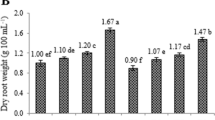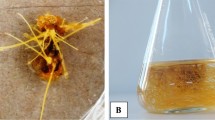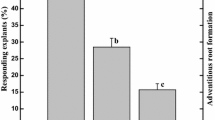Abstract
The aim of this study was to determine the effects of 24-epibrassinolide (24-eBL) and l-phenylalanine (l-phy) on the root growth, total phenolics, total flavonoids, and caffeic acid derivatives’ (CADs) accumulation in Agrobacterium rhizogenes-mediated hairy roots of Echinacea purpurea. For this aim, different concentrations of 24-eBL (0.5, 1.0 and 2.0 mg L−1) and l-phy (100, 500, and 1000 µM) were applied to hairy roots and the roots were harvested five times at 10 day intervals. After harvest, hairy roots were evaluated for fresh root weight, dry root weight, growth index, and the contents of total phenolics, total flavonoids, and CADs. The highest fresh root weight, dry root weight, and growth index were obtained from the roots treated with 0.5 mg L−1 24-eBL and harvested at 50 days after treatment, while l-phy had no significant influence on root growth. Among the 24-eBL applications, 1.0 mg L−1 24-eBL was found as the optimum concentration, providing the highest total phenolics, total flavonoids, cichoric acid, caftaric acid, echinacoside, and p-coumaric acid contents. On the other hand, 500 μM l-phy was determined as the most suitable l-phy treatment for giving the maximum values in terms of all investigated parameters. In terms of harvesting period, 50th day was the most appropriate harvest time for secondary metabolite accumulation. Consequently, the results showed that 24-eBL and l-phy treatments can be successfully increased the production of secondary metabolites in transgenic hairy roots of E. purpurea and 24-eBL implementations could be a more effective strategy when compared to l-phy.



Similar content being viewed by others
References
Abbasi BH, Tian CL, Murch SJ, Saxena PK, Liu CZ (2007) Light-enhanced caffeic acid derivatives biosynthesis in hairy root cultures of Echinacea purpurea. Plant Cell Rep 26:1367–1372
Abdoli M, Moieni A, Naghdi Badi H (2013) Influence of KNO3, CaCl2 and MgSO4 concentrations on growth and cichoric acid accumulation in hairy root culture of purple coneflower (Echinacea purpurea L.). J Med Plants 1(45):75–84
Ahammed GJ, Zhou YH, Xia XJ, Mao WH, Shi K, Yu JQ (2013) Brassinosteroid regulates secondary metabolism in tomato towards enhanced tolerance to phenanthrene. Biol Plant 57(1):154–158
Al-Gendy AA, Bakr RO, El-Gindi OD (2015) Production of flavonoids and phenolic compounds by elicitation of Iphiona mucronata (Forssk.) Asch. Schweinf (Asteraceae) callus and suspension cultures. IJPPR 30(1):1293–1300
Bao F, Shen J, Brady SR, Muday GK, Asami T, Yang Z (2004) Brassinosteroids interact with auxin to promote lateral root development in Arabidopsis. Plant Physiol 134(4):1624–1631
Boudet AM (2007) Evolution and current status of research in phenolic compounds. Phytochem 68(22):2722–2735
Chiou SY, Sung JM, Huang PW, Lin SD (2017) Antioxidant, antidiabetic and antihypertensive properties of Echinacea purpurea flower extract and caffeic acid derivatives using in vitro models. J Med Food 20(2):171–179
Clouse SD, Sasse JM (1998) Brassinosteroids: Essential regulators of plant growth and development. Annu Rev Plant Physiol Plant Mol Biol 49:427–451
Clouse SD, Zurek D (1991) Molecular analysis of brassinolide action in plant growth and development. In: Cutler HG, Yokota T, Adam G (eds) Brassinosteroids; chemistry, bioactivity and applications, ACS syrup series 474. American Chemical Society, Washington, DC, pp 122–140
Çoban Ö, Göktürk Baydar N (2016) Brassinosteroid effects on some physical and biochemical properties and secondary metabolite accumulation in peppermint (Mentha piperita L.) under salt stress. Ind Crops Prod 86:251–258
Çoban Ö, Göktürk Baydar N (2017) Brassinosteroid modifies growth and essential oil production in peppermint (Mentha piperita L.). J Plant Growth Regul 36(1):43–49
Contin A, Van Der Heijden R, Verpoorte R (1999) Effects of alkaloid precursor feeding and elicitation on the accumulation of secologanin in a Catharanthus roseus cell suspension culture. PCTOC 56(2):111–119
Cosgrove DJ (1997) Relaxation in a high-stress environment: the molecular bases of extensible cell walls and cell enlargement. Plant Cell 9(7):1031–1041
Dörnenburg H, Knorr D (1997) Challenges and opportunities for metabolite production from plant cell and tissue cultures. Food Technol 51:47–53
Edahiro JI, Nakamura M, Seki M, Furusaki S (2005) Enhanced accumulation of anthocyanin in cultured strawberry cells by repetitive feeding of l-phenylalanine into the medium. J Biosci Bioeng 99(1):43–47
Farooq M, Wahid A, Basra SMA (2009) Improving water relations and gas exchange with brassinosteroids in rice under drought stress. J Agron Crop Sci 195(4):262–269
Felner M (2003) Recent progress in brassinosteroid research: hormone perception and signal transduction. In: Hayat S, Ahmad A (eds) Brassinosteroids: bioactivity and crop productivity. Kluwer Academic Publishers, Dordrecht
Fett-Neto AG, Zhang WY, Dicosmo F (1994) Kinetics of taxol production, growth, and nutrient uptake in cell suspensions of Taxus cuspidate. Biotechnol Bioeng 44:205–210
Giri A, Narasu M (2000) Transgenic hairy roots: recent trends and application. Biotechnol Adv 18:1–22
Hu ZB, Du M (2006) Hairy root and its application in plant genetic engineering. J Integr Plant Biol 48(2):121–127
Jacob A, Malpathak N (2005) Manipulation of MS and B5 components for enhancement of growth and salsodine production in hairy root cultures of Solanum khasianum Clarke. PCTOC 80:247–257
Jones AMP, Saxena PK, Murch SJ (2009) Elicitation of secondary metabolism in Echinacea purpurea L. by gibberellic acid and triazoles. Eng Life Sci 9(3):205–210
Kindscher K (1989) Ethnobotany of purple coneflower (Echinacea angustifolia Asteraceae) and other Echinacea species. Econ Bot 43(4):498–507
Koca N, Karaman Ş (2015) The effects of plant growth regulators and l-phenylalanine on phenolic compounds of sweet basil. Food Chem 166:515–521
Kumar KM, Ramaiah S (2011) Pharmacological importance of Echinacea purpurea. IJPBS 2(4):304–314
Kuzovkina IN, Schneider B (2006) Genetically transformed root cultures—generation properties and application in plant sciences. Prog Bot 67:275–324
Lindsey K, Yeoman MM (1984) The synthetic potential of immobilised cells of Capsicum frutescens Mill cv. Annuum. Planta 162(6):495–501
Liu C, Long J, Zhu K, Liu L, Yang W, Zhang H, Li L, Xu Q, Deng X (2016) Characterization of a citrus R2R3-MYB transcription factor that regulates the flavonol and hydroxycinnamic acid biosynthesis. Sci Rep 6:25352
Liu CZ, Abbasi BH, Gao M, Murch SJ, Saxena PK (2006) Caffeic acid derivatives production by hairy root cultures of Echinacea purpurea. J Agric Food Chem 54:8456–8460
Liu R, Li W, Sun LY, Liu CZ (2012) Improving Root growth and cichoric acid derivatives production in hairy root culture of Echinacea purpurea by ultrasound treatment. Biochem Eng J 60:62–66
Maniatis T, Fritsch EF, Sambrook J (1982) Molecular cloning: a laboratory manual, vol 545. Cold Spring Harbor Laboratory, Cold Spring Harbour
Mobin M, Wu CH, Tewari RK, Paek KY (2015) Studies on the glyphosate induced amino acid starvation and addition of precursors on caffeic acid accumulation and profiles in adventitious roots of Echinacea purpurea (L.) Moench. PCTOC 120(1):291–301
Murthy HN, Kim YS, Park SY, Paek KY (2014) Biotechnological production of caffeic acid derivatives from cell and organ cultures of Echinacea species. Appl Microbiol Biotechnol 98(18):7707–7717
Naeem M, Idrees M, Alam MM, Aftab T, Khan MMA (2012) Brassinosteroid-mediated enrichment in yield attributes, active constituents and essential oil production in Mentha arvensis L. Russ Agric Sci 38(2):106–113
Ng TLM, Karim R, Tan YS, Teh HF, Danial AD, Ho LS, Khalid N, Appleton DR, Harikrishna JA (2016) Amino acid and secondary metabolite production in embryogenic and non-embryogenic callus of Fingerroot ginger (Boesenbergia rotunda). PLoS ONE 11(6):e0156714
Oh MH, Clouse SD (1998) Brassinolide affects the rate of cell division in isolated leaf protoplasts of Petunia hybrid. Plant Cell Rep 17(12):921–924
Oláh A, Szabó-Papp J, Soeberdt M, Knie U, Dähnhardt-Pfeiffer S, Abels C, Bíró T (2017) Echinacea purpurea-derived alkylamides exhibit potent anti-inflammatory effects and alleviate clinical symptoms of atopic eczema. J Dermatol Sci 88(1):67–77
Palacio L, Cantero JJ, Cusidó R, Goleniowski M (2011) Phenolic compound production by Larrea divaricata Cav. plant cell cultures and effect of precursor feeding. Process Biochem 46(1):418–422
Pleschka S, Stein M, Schoop R, Hudson JB (2009) Anti-viral properties and mode of action of standardized Echinacea purpurea extract against highly pathogenic avian influenza virus (H5N1 H7N7) and swine-origin H1N1 (S-OIV). Virol J 6(1):197
Rady MM (2011) Effect of 24-epibrassinolide on growth yield antioxidant system and cadmium content of bean (Phaseolus vulgaris L) plants under salinity and cadmium stress. Sci Hortic 129(2):232–237
Sabra A, Adam L, Daayf F, Renault S (2012) Salinity-induced changes in caffeic acid derivatives alkamides and ketones in three Echinacea species. Environ Exper Bot 77:234–241
Sathiyamoorthy P, Nakamura S (1990) In vitro root induction by 24-epibrassinolide on hypocotyl segments of soybean (Glycine max L.) Merr. Plant Growth Regul 9(1):73–76
Schapowal A, Klein P, Johnston SL (2015) Echinacea reduces the risk of recurrent respiratory tract infections and complications: a meta-analysis of randomized controlled trials. Adv Ther 32(3):187–200
Shanks JV, Morgan J (1999) Plant ‘hairy root’culture. Curr Opin Biotechnol 10(2):151–155
Singleton VL, Rossi JA (1965) Colorimetry of total phenolics with phosphomolybdic-phosphotungstic acid reagents. AJEV 16(3):144–158
Stiegler CD (2017) Echinacea: herbal medicine with a wild history. Ethnobiol Lett 8(1):56–57
Tanaka K, Nakamura Y, Asami T, Yoshida S, Matsuo T, Okamoto S (2003) Physiological roles of brassinosteroids in early growth of Arabidopsis: brassinosteroids have a synergistic relationship with gibberellin as well as auxin in light-grown hypocotyl elongation. J Plant Growth Regul 22(3):259–271
Tuan PA, Kwon DY, Lee S, Arasu MV, Al-Dhabi NA, Park NI, Park SU (2014) Enhancement of chlorogenic acid production in hairy roots of platycodon grandiflorum by over-expression of an Arabidopsis thaliana transcription factor AtPAP1. Int J Mol Sci 15(8):14743–14752
Tzin V, Galili G (2010) The biosynthetic pathways for shikimate and aromatic amino acids in Arabidopsis thaliana. In: The Arabidopsis book/American Society of Plant Biologists, vol 8
Vats S, Kamal R (2014) Cassia occidentalis L. (a new source of rotenoids): it’s in vitro regulation by feeding precursors and larvicidal efficacy. PCTOC 116(3):403–409
Wang HM, To KY (2004) Agrobacterium-mediated transformation in the high-value medicinal plant Echinacea purpurea. Plant Sci 166(4):1087–1096
Wu CH, Tewari RK, Hahn EJ, Paek KY (2007) Nitric oxide elicitation induces the accumulation of secondary metabolites and antioxidant defense in adventitious roots of Echinacea purpurea. J Plant Biol 50:636–643
Acknowledgements
The authors are thankful to TUBITAK (Scientific and Technological Research Council of Turkey) for the financial support for this research Project (TOVAG, 1001, project no: 213O257).
Author information
Authors and Affiliations
Corresponding author
Additional information
Communicated by F. Araniti.
Publisher's Note
Springer Nature remains neutral with regard to jurisdictional claims in published maps and institutional affiliations.
Rights and permissions
About this article
Cite this article
Demirci, T., Çelikkol Akçay, U. & Göktürk Baydar, N. Effects of 24-epibrassinolide and l-phenylalanine on growth and caffeic acid derivative production in hairy root culture of Echinacea purpurea L. Moench.. Acta Physiol Plant 42, 66 (2020). https://doi.org/10.1007/s11738-020-03055-7
Received:
Revised:
Accepted:
Published:
DOI: https://doi.org/10.1007/s11738-020-03055-7




